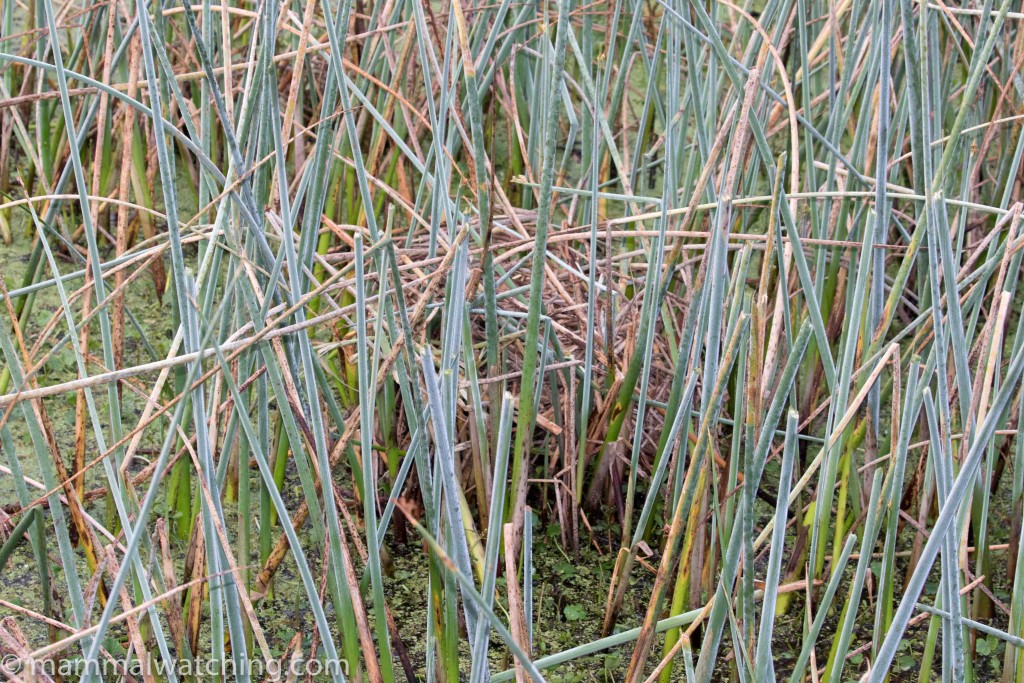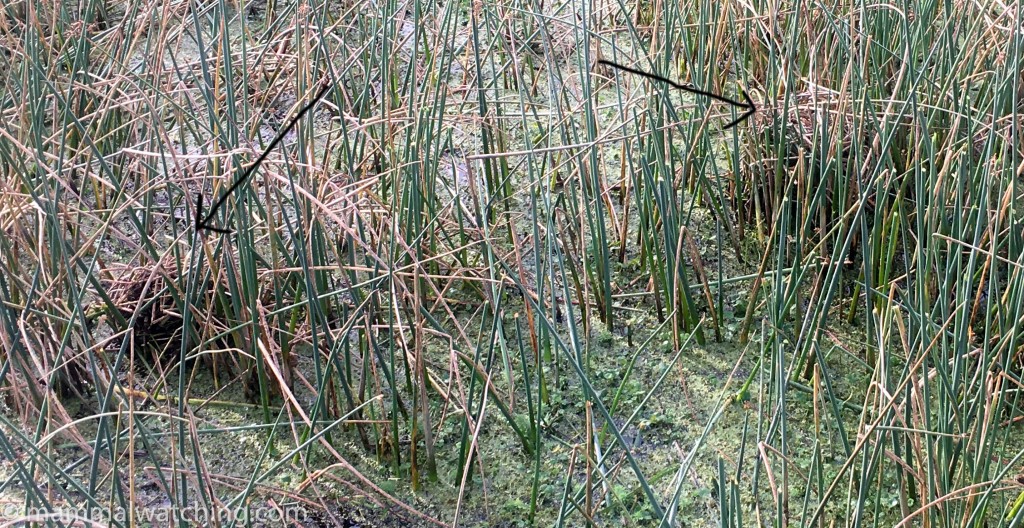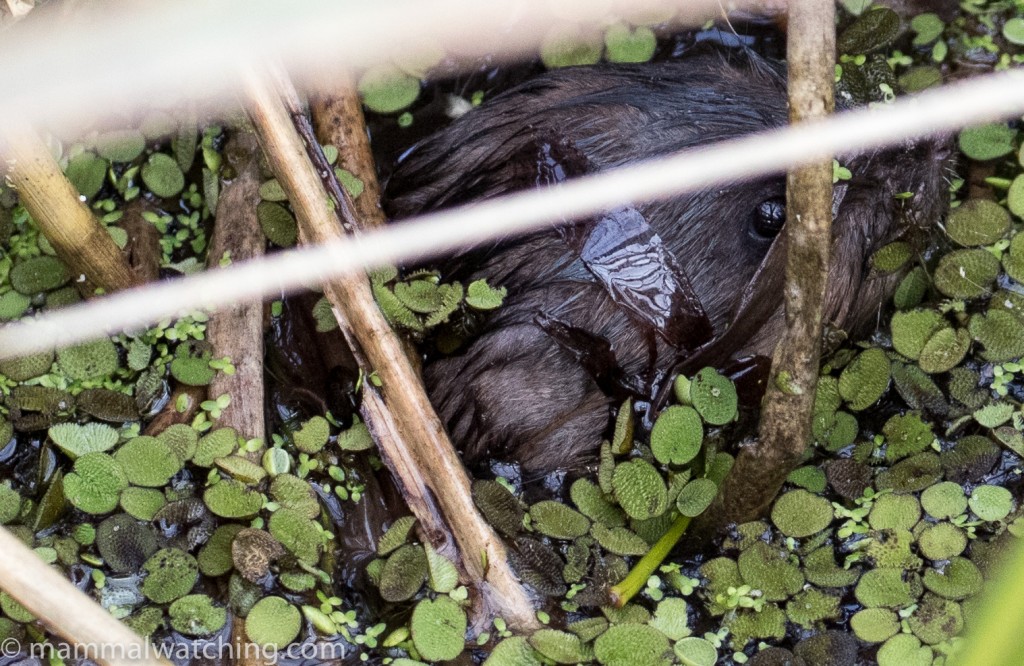Round-tailed Muskrat …. finally
I moved to the USA six years ago and one of the very first trips I took was with John Fox to look for Round-tailed Muskrats in Georgia. We didn’t see one. Nor did I see one over the course of several trips to West Palm Beach, two to Orlando and at least three to the Jacksonville area. I must have spent over 100 hours looking for this species and not gotten close.
In 2016, Scott Flamand, who was aware of my neofiber-frustration, sent me a photo of an animal he’d seen near his home in Gainesville, Florida. Round-tailed Muskrats were, Scott told me, being seen quite regularly at the new Sweetwater Wetlands Reserve. I went up three months later to see Scott …. but it was a couple of months too late. While the animals were pretty easy to spot in January and February, when the wetland vegetation was relatively sparse, they are much harder to find during the rest of the year when there is much more vegatation cover.
I couldn’t get down last year, but I returned last weekend to stay with Scott and spent eight hours on Saturday, and another three on Sunday, staring into the reeds.
The wetlands are a popular destination (both with birders and familes out for a stroll). They are bursting with avian life along with alligators, turtles, and mammals too: I had a nice look at a Bobcat there back in 2016, and people reported seeing River Otters while I was there at the weekend. There are also Marsh Rice Rats, Bison, feral pigs and horses.

Round-tailed Muskrat lodge
But Scott and I only had eyes for the muskrats. We decided to stake out two active muskrat lodges close to the boardwalk. The lodges, though distinctive when you spot them, don’t stand out all that well: they are nothing more than a scruffy nest of vegetation about 50% bigger than a bowling ball.
I am not sure if this is standard muskrat building code, but both of the lodges we were staking out comprised two nests a metre or so apart.

Round-tailed Muskrat lodges
Although Round-tailed Muskrats are predominantly crepuscular/nocturnal they are occasionally active in the day. A local birder told me he had seen them on cold windy days and bright sunny days recently but they were “very hit and miss”. He also said that you might more often notice the reeds moving under the water, or hear the animals chewing on vegetation, than see the creatures themselves.
Scott spotted some movement by a lodge at 10 a.m. on Saturday morning but didn’t see an animal. The wetlands close at sunset and, right on sunset, one of the lodges started moving and shortly afterwards we saw a brown back glide jerkily through the water for a couple of seconds before submerging. A muskrat, but a far from satisfactory look. And there was no chance of getting a better look as the ranger arrived a minute later to politely let us know it was past closing time.
I returned at 7 a.m. the next morning and at 9 a.m. heard a distinctive munching noise coming from close the boardwalk on the opposite side to a lodge. Five minutes later a Round-tailed Muskrat surfaced below me and carried on feeding long enough for me to grab a couple of bad photos.

Round-tailed Muskrat, Neofiber alleni
Perhaps not the most exciting mammal of my life, but one of the most time consuming and one that is strangely fascinating for a few of us I know. At least they are in a genus of their own.
Thank you very much to Scott Flamand for his generous hospitality (again!) and the effort he put in to helping me find a muskrat.
Jon
10 Comments
-
mattinidaho
Well done, Jon. A unique and interesting mammal. You are really getting ticking off the North America species, even the tough ones…
-
Maurice Tijm
Nice species and a great invitation.
I fascinates me that in the cultivated western countries it often are the marsh inhabitants that remain the hardest for us to find (watervoles, otter, muskrat, water shrew, mink, crakes, bitterns). Humans just like past times still have problems to get good access such habitats.
-
jshrader
Hello Jon:
We just wanted to let you know that we recently found your posting about the Round-tailed Muskrat and put the information to good use earlier this month.
About a two weeks ago now, we spent a few days in the Orlando area. . . to attend a professional meeting. On Saturday, March 3, 2018, we had the day “off” and although the weather had turned cold and windy, it was very, very clear. We’ve seldom seen it so clear in Florida! Although it was a very beautiful day, it took most of the morning to warm up enough to be comfortable outdoors (due to the wind.) We drove north from Orlando about two hours to the Gainesville area, to the wildlife refuge you referred to in your report called Sweetwater Wetlands Park. It is apparently a relatively new park – open only a couple of years. The main purpose is to provide settling basins for the storm water from Gainesville, but they have constructed a beautiful boardwalk, and a couple miles of nice trails along the dikes, and it was being used by a lot of birders and people out just enjoying the outdoors and nature. The place is full of birds, and it was a perfect place to go. Karen wanted to practice with her camera and there were plenty of avian subjects for her to snap photos of. However, the main reason that took us there was that we had read your report online on your website and given that you had just managed to see a Round-tailed Muskrat there along the boardwalk a little over a month earlier in late January, we figured we’d give it a shot. Using your directions, we spent an hour and a half looking and finally found the lodges you had described. By then it was 8:30 a.m. (we got there at 7:00 a.m. when the place opened) and very sunny. We didn’t think we’d have a chance at that point, because this mammal is mostly nocturnal, and also at times crepuscular. However, while just standing there looking, Karen noticed that the plants were moving down below us, just as described in your posting. We zeroed in on the area, and sure enough we saw the brown furry back of the muskrat! We saw the mammal a couple of times over a twenty minute period. . . While I would have liked to see the whole animal sitting on top of a lodge (maybe another time. . . next year?) I was delighted to see it at all. Karen saw one back in 1992 when we were birding at Merritt Island National Wildlife Area by Cape Canaveral. She saw it swimming, and at the time we didn’t realize the importance of her sighting. As you said, this mammal is extremely difficult to see and while I haven’t spent over 100 hours looking like you did, I have been looking for this little critter ever since 1992 when Karen saw one! (25 years!) I have tried a number of times in Florida – at Merritt Island, near Orlando, near Ft. Lauderdale, and in the Everglades without so much as a glimpse of anything remotely resembling a muskrat! Thanks to your posting, we found the exact lodges you had found, and then amazingly found the animal relatively quickly as well. Obviously, if we could get into the park at night, it would probably take about five minutes to find the mammal, but it is closed from sunset to sunrise, likely for a very good reason. The place was full (infested?) with alligators. Not little ones. Big ones! Really, really BIG ones! During the day they are typically pretty sedate, but at night they “come alive!” And, they can run over 10 miles an hour. We are reasonably fast, but not THAT fast. . . We thought that you’d like to know that it is still possible to find the muskrat at the end of February / beginning of March. The vegetation was growing, but we were still able to see the water quite well around the lodges. Attached is a photo in case you’d like to see the progression of growth over the last 5-6 weeks. As we looked around carefully we noticed there were actually about ten different lodges in the area – some looked newer than others. In addition, we saw a Marsh Rabbit (see attached) near the beginning of the boardwalk when we arrived and about 60 species of birds during our five hours at the park, despite a lot of people walking all around. . . all of whom seemed happy to be outdoors. They were well-behaved, and had no impact on our ability to see the muskrat.
We love your website! Thanks for creating such a user-friendly website with such valuable information to the worldwide community of “mammal watchers!”
John and Karen Shrader
Centerville, Ohio, USA -
Scott Flamand
If anyone needs help looking for the muskrat here in Gainesville feel free to contact me. I would be glad to help. I go out there pretty regularly and I keep track of other people’s sightings of this little beast. Scottflamand@gmail.com
Leave a Reply
You must be logged in to post a comment.


Judy Leitch
What a great find!